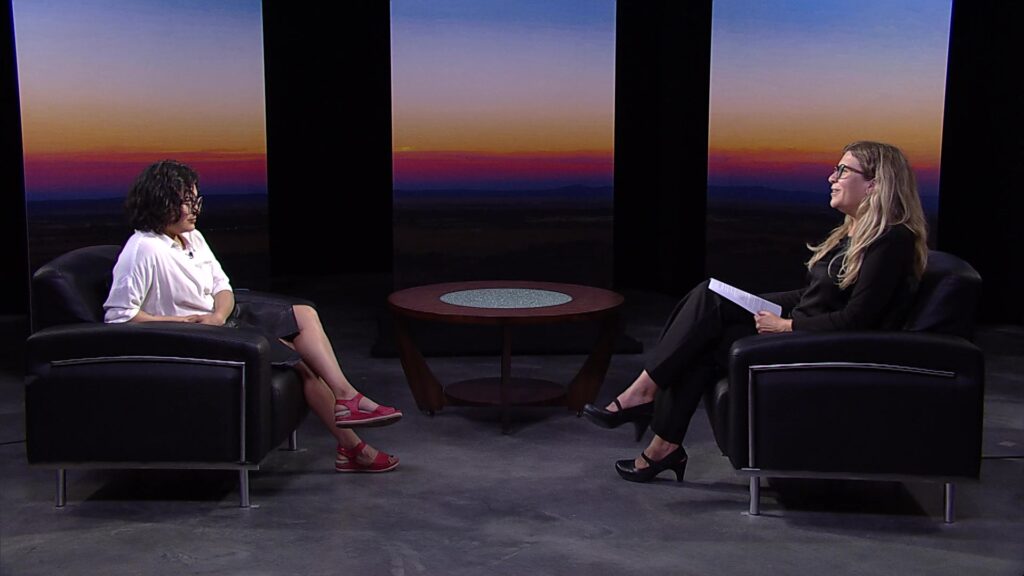‘a little bit of colonialism and a little bit of imperialism’

Coming up this week, we’ll air an interview with Searchlight New Mexico’s investigative reporter Alicia Inez Guzmán, who covers New Mexico’s nuclear legacy and future — and the New Cold War.
In that conversation, Guzmán and I dive deep into her award-winning story, “Buried secrets, poisoned bodies,” the illegal autopsies scientists at Los Alamos National Laboratory and doctors at the Los Alamos Medical Center performed on people for over 35 years, and the unique challenges of being a reporter on the 21st century atomic beat. (And there’s a sneak peek of that conversation on Instagram.)
If you missed New Mexico in Focus last Friday, you can still watch a conversation with Thoreau High School students Reagan Russette, MiaBella Burrola, and Ezekiel Gonzales.
“I think it’s like, a little bit of colonialism and a little bit of imperialism,” said Burrola when talking about the prevalence of uranium mines on Indigenous lands. “…There’s a lot of uranium mines and dumps on the Navajo Nation compared to other spots; it’s all on Native land. It’s like, ‘We’ve got all kinds of power and you guys are just the poor brown people that we could just dump our waste on. Because nobody cares about you.’”
Earlier this year, they and other tenth graders from Thoreau wrote to media outlets and officials across the state, drawing attention to a recommended cleanup plan from the federal government. Our conversation was tough and surprising, and I hope you’ll watch it.
In the news:
• “’I have nothing now’: Redirection of Rio Chama flows through homes in Medanales” (Nicholas Gilmore, Santa Fe New Mexican)
• “Bishop’s Lodge treated wastewater plans continue to rile neighbors” (Scott Wyland, Santa Fe New Mexican)
• “Unanswered questions: New Mexico looks to fossil fuel byproduct to ease pressure on freshwater supplies” (Hannah Grover, New Mexico Political Report)
• “Mescalero Apache members speak out on the impact of the South Fork and Salt fires” (Jeanette DeDios, KUNM)
• “When a utility sparks a wildfire, who pays?” (Kylie Mohr, High Country News)
• “From sheep camp to the city to study uranium’s damage to Navajo people” (Alastair Lee Bitsóí, Arizona Mirror)
• “Arizona Supreme Court gives Resolution Copper a win in wastewater discharge appeal” (David Abbott, Arizona Mirror)
• “Officials celebrate 3,700-acre Taos Overlook acquisition” (Rick Romancito, Taos News)
• “What the Supreme Court Chevron decision means for environmental rules” (Maxine Joselow, The Washington Post)
• “Scientists found another way we’re exposed to ‘forever chemicals’: Through our skin” (Amudalat Ajasa, The Washington Post)
• “Financing of Meat and Dairy Giants Grows Thanks to Big American Banks and Investors” (Georgina Gustin, Inside Climate News)
• “Why Beryl Is a Bad Sign for This Year’s Hurricane Season” (Judson Jones, The New York Times) * As a note, Hurricane Beryl “flattened” Carriacou in a half-hour.
• “EPA chief seeks to reassure employees as specter of Trump looms” (Maxine Joselow, The Washington Post)
And here are a few must-read articles if you want to understand what the U.S. Supreme Court did last week for the future of environmental and public health regulation in our nation:
• “Justices Limit Power of Federal Agencies, Imperiling an Array of Regulations” (Adam Liptak, The New York Times)
• “Supreme Court curtails agencies’ ability to enforce regulations” (Erin X. Wong, High Country News)
• “What the Supreme Court Chevron decision means for environmental rules” (Maxine Joselow, The Washington Post)
• “What the Chevron decision means for health policy” (Rachel Roubein, The Washington Post)
If you’re looking for an all-too-relevant blast from the past, check out this 2022 interview with Colleen Haffey, former New Mexico State Forestry Coordinator of the Forest & Watershed Health Office, “NM is ‘losing the war’ on climate, fire, and flood.” And, earlier this summer, a high school student, Cora Bixby, helped me out with a bunch of different things, including social media. On our website right now, we’re featuring an essay from her, “One World.”
And I know, friends, this newsletter is chock full of hard-to-read news. The whole world is full of hard-to-read news. And if you spend even a few minutes a day on social media, you’re also exposed to the perpetual rage machine of the algorithms. Staying informed and educated is important. And so is resisting the urge to harden your heart. I was reminded of that this morning when I picked up my old copy of Pema Chödrön’s tiny book “Practicing Peace in Times of War.”
“War begins when we harden our hearts, and we harden them easily — in minor ways, and then in quite serious, major ways, such as hatred and prejudice — whenever we feel uncomfortable. It’s so sad, really, because our motivation in hardening our hearts is to find some kind of ease, some kind of freedom from the distress we’re feeling,” Chödrön writes, adding a few pages later: “So what I’m advocating for here is something that requires courage — the courage to have a change of heart. The reason this requires courage is because when we don’t do the habitual thing, hardening our heart and holding tightly to certain views, then we’re left with the underlying uneasiness, that feeling of threat…If we can stay with the soft spot and stay with the tender heart, then we are cultivating the seeds of peace.”
And speaking of hearts, check out the promo for our upcoming special:
And if you’re an avid YouTube user, please subscribe to the Our Land channel!
P.S. If a friend forwarded you this message, sign up here to receive the newsletter yourself. You can also read recent newsletters online. And if you miss us throughout the week, follow Our Land on Instagram.


